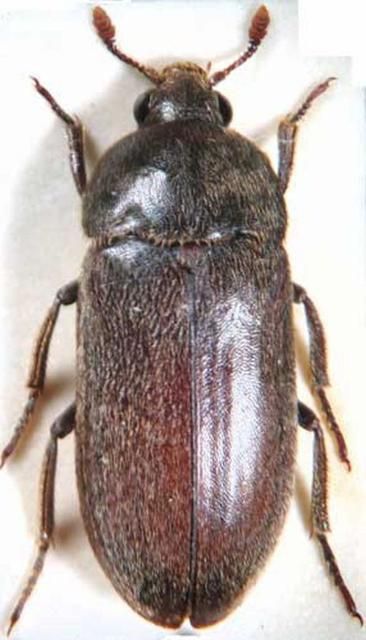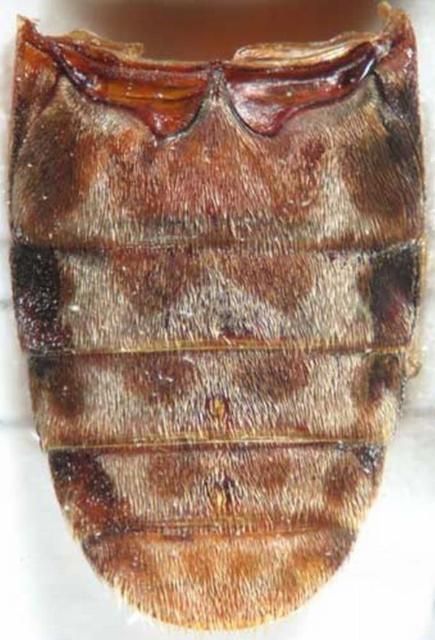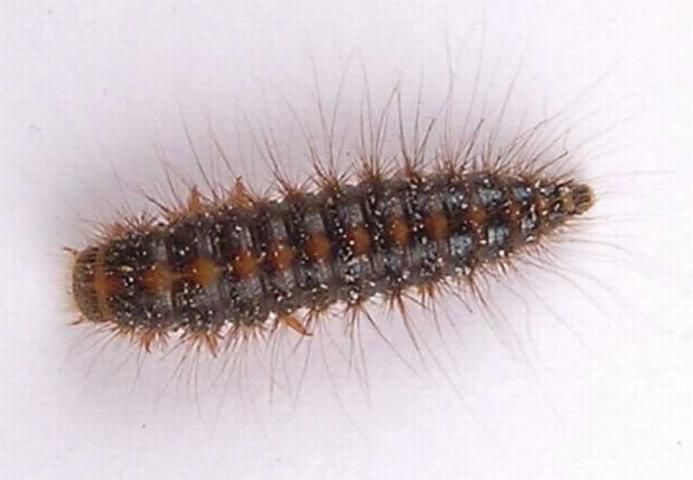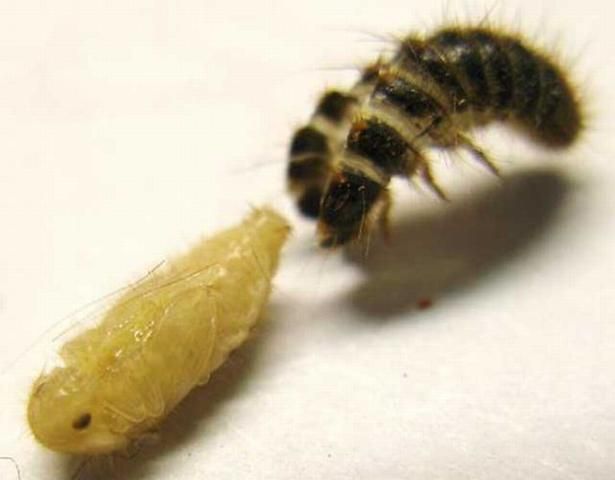The Featured Creatures collection provides in-depth profiles of insects, nematodes, arachnids and other organisms relevant to Florida. These profiles are intended for the use of interested laypersons with some knowledge of biology as well as academic audiences.
Introduction
The black larder beetle, Dermestes ater DeGeer, is a cosmopolitan species that feeds on various plant and animal products, although it scavenges more on dead insects and carrion. It is a common pest of cheese, dried fish, leather (Illingworth 1916), copra (Aitken 1975), silk (Ansari and Basalingappa 1987, Kumar et al. 1988), wool (Bennett et al. 1988), milk powder (Champ 2003) and has been associated with incinerator-burnt waste materials (Byrd and Castner 2009).
Dermestes ater also serves as an intermediate host for tapeworms in poultry (Avancini and Ueta 1990, Ueta and Avancini 1994). Dermestes ater larvae are very important in helping estimate the postmortem interval of corpses (Voss et al. 2008). According to Byrd and Castner (2009), D. ater frass (feces) can be used as an alternative DNA and toxicology sample, as well as an indicator to help support the postmortem interval estimation. Other important dermestid species which are of similar importance are the hide beetle, Dermestes maculatus DeGeer and the larder beetle, Dermestes lardarius Linnaeus.
Synonymy
Dermestes ater DeGeer, 1774
Dermestes cadaverinus Fabricius, 1775
Dermestes piceus Thunberg, 1781
Dermestes felinus Fabricius, 1787
Dermestes domesticus Germar, 1824
Dermestes cadaverinus ab. domesticus: Erichson, 1846
Dermestes hispidulus Montrouzier, 1860
Dermestes chinensis Motschulsky, 1866
Dermestes subcostatus Murray, 1867
Dermestes noxius Mulsant and Rey, 1868
Dermestes favarcqui Godard, 1883
Dermestes ater var. domestica Blackwelder, 1945
Dermestes ruficapicalis Pic, 1951
(Herrmann 2010)
Distribution
Dermestes ater is native to North America and Hawaii (ITIS 2010) but is distributed in all zoogeographical regions of the world.
In Florida, it has been reported in Alachua, Broward, Clay, Miami-Dade, Duval, Gilchrist, Jackson, Manatee, Monroe, Orange, Seminole, and Volusia counties (Peck and Thomas 1998).
Description
Adult
The adult is about 7 to 9 mm in length with black or brown un-serrated elytra (beetle forewings) (Robinson 2005). It lacks an ocellus (simple eye) (Gennard 2007) and the whole body is covered with yellowish-grey hair (Hedges and Lacey 1996). On both the third and fourth segment of the abdominal sternites, the adult male has a small stout bristle surrounded by golden-colored bristles, which the female lacks (Roth and Willis 1950). The adult is also cannibalistic on all instars and pupae.

Credit: Andreas Herrmann, http://www.dermestidae.com/ Used with permission
The underside of the abdomen is light brown with dark brown patches in the middle and on the sides (Mound 1989). This characteristic distinguishes D. ater from D. lardarius (larder beetle), which has an underside lighter in color (Hedges and Lacey 1996).

Credit: Andreas Herrmann, http://www.dermestidae.com/ Used with permission
Egg
The egg is elongate and measures around 1.9 mm long x 0.48 mm wide (Kumar et al. 1988). It has fine processes on both ends and is pearly white in color when first laid, but the egg will appear pebbled as the embryo matures (Roth and Willis 1950).
Larva
The newly-hatched larva is white with rows of dark bristles but the body gradually darkens after each molt (Roth and Willis 1950). As the larva matures, the color ranges from reddish-brown to black (Hedges and Lacey 1996). It has a discontinuous yellow stripe which runs along the middle of the back (Hedges and Lacey 1996) and is about 10 to 14 mm long (Robinson 2005). It also has a pair of broadly-based urogomphi that point vertically (Robinson 2005) and are not strongly curved (Byrd & Castner 2009). An urogomphus is a process or spine on the last segment of certain insect larvae. This distinguishing character of the urogomphi differentiates D. ater from D. lardarius (larder beetle), whose urogomphi point upwards and backwards away from the body, and D. maculatus (hide beetle), whose urogomphi point upwards and inwards towards the body (Hedges and Lacey 1996). The larva is cannibalistic on all instars and eggs (Roth and Willis 1950).

Credit: Dave Hodges, http://www.thewcg.org.uk/ Used with permission
Pupa
The pupa is oval-shaped, and at this stage the sex of D. ater can be determined. The pair of side projections on the underside of the last abdominal segment is fleshier in the female than in the male (Roth and Willis 1950).

Credit: Scott Nacko, Used with permission
Life Cycle
The egg hatches in about two days at 35°C and six days at 21°C (Robinson 2005). Larval development is about 19 days for six to seven instars at 35°C and 50 days for seven to nine instars at 21°C (Robinson 2005). The variable numbers of instars is dependent on factors such as sex and the availability of food and water. Humidity is also an important factor in larval development. At 25°C, larval development is 50 days at 80% and 60 to 70 days at 40% relative humidity (Coombs 1981).
Pupal development takes about five days at 35°C and 12 days at 21°C (Robinson 2005).
For adults, the pre-oviposition period is four days at 30°C and 33 days at 25°C, followed by a two month oviposition period (Coombs 1981). A female lays either a single egg or batches of 17 to 25 eggs, while the number of eggs laid by a female in her lifetime ranges from 200 to 800 eggs (Robinson 2005). At 21°C, adult D. ater males and females can live up to 169 and 173 days, respectively (Robinson 2005).
Economic Importance
Dermestes ater is a pest of various food and non-food items worldwide (Rajendran and Hajira Parveen 2005). It is an important pest of museum collections (Gonsalves 2003) and fishmeal-processing factories (Haines and Rees 1989). Together with D. maculatus (hide beetle), black larder beetles are major pests of dried fish in Zambia (Proctor 1970) and the salted fish industry in Indonesia (Heruwati 2002). Dermestes ater poses a serious threat in silk production because it preys upon adult silkworm moths (Kumar et al. 1988) and damages the silkworm cocoon to feed on the silkworm pupa within (Ayuzawa et al. 1972). According to Veer et al. (1996), silk production in Mysore, India suffered a 20% loss due to D. ater.
Veterinary Importance
Dermestes ater was the principal intermediate host of the parasitic tapeworm Raillietina laticanalis (Skrjabin) in a poultry facility in southeastern Brazil (Ueta and Avancini 1994). The beetle was also found hosting the tapeworm Choanotaenia infundibulum (Bloch), which parasitizes poultry, resulting in lower egg production and reduced growth and weight in birds (Avancini and Ueta 1990).
Forensic Importance
According to Byrd and Castner (2009), D. ater is very important in forensic science. An infestation on a human corpse in Malaysia suggested that D. ater adults arrived at an early stage of decomposition (Kumara 2009). In a study of decomposition and insect succession on pig carcasses under different conditions in the summer, D. ater adults were found on carcasses as early as two days (bloat stage) while the larvae were present from the dry stage (15 to 36 days) until the skeletal stage (>34 days) (Voss et al. 2008). In the fall, larvae were collected as early as the wet stage (5 to 17 days) until the skeletal stage (>41 days) (Voss et al. 2008). Adult dermestids have been reported to skeletonize a body in 24 days (Byrd and Castner 2009). However, only the larval stages are used to estimate the post mortem interval, which is based on the understanding of the history of larval development at a given condition.
The presence of frass suggests a long post mortem interval, and it can be used as an alternative DNA or toxicology sample (Byrd and Castner 2009). In the study of mummies, the presence of D. ater was used as a non-destructive tool to indicate the cadaver's exposure time prior to mummification (Figueiredo 2004).
Management
Inspection
Homeowners and pest control operators investigating an infestation should inspect the kitchen, pantry, garage and basement where cheese, meats, fish, dried pet food, insect collections and mounted animals are stored. The attic and crawlspace are also good places to find the source of infestation because they may conceal dead insects, rodents, birds and reptiles, which are all food sources for D. ater. Another good indicator is the presence of frass on the attacked material. Dermestid frass is very distinct in appearance. It is dark brown, dry and stringy because the feces wrapped by the remnants of the peritrophic membrane, which is a secretion in insects that occurs in the digestive tract (Byrd and Castner 2009).
Cultural Control
Prevention and control are best achieved through good sanitation practices.
Physical Control
Installing screens and sealing cracks and crevices can serve as exclusion methods from outside. Other physical methods include pheromone traps and cold and heat treatment.
Chemical Control
While residual insecticide sprays have been used, if an infestation is severe the best method for control may be fumigation.
Selected References
Aitken AD. 1975. Insect Travellers. Volume I. Coleoptera. Technical Bulletin, Ministry of Agriculture, Fisheries and Food 31: 1-191.
Ansari MS, Basalingappa S. 1987. Percent infestation of silkworm cocoons of Bombyx mori by the larvae of the beetle Dermestes ater DeGeer (Dermestidae: Coleoptera) Sericologia 27: 587-592.
Avancini RM, Ueta MT. 1990. Manure breeding insects (Diptera and Coleoptera) responsible for cestoidosis in caged layer hens. Journal of Applied Entomology 110: 307-312.
Ayuzawa C, Sekido I, Yamakawa K, Sakurai U, Kurata W, Yaginuma Y, Tokoro Y. 1972. Handbook of Silkworm Rearing. Fuji Publishing Company, Tokyo. 211 pp.
Bennett GW, Owens JM, Corrigan RM. 1988. Truman's Scientific Guide to Pest Control Operations, Fourth Edition. Edgell Communications, USA. 522 pp.
Byrd JH, Castner JL. 2009. Insects of forensic importance. In Byrd JH, Castner JL (Editors), Forensic Entomology: The Utility of Arthropods in Legal Investigations (2nd Edition). pp. 97-100. CRC Press, Boca Raton, FL. 688 pp.
Champ BR. 2003. Insect pests of stored products in Australia. In Prakash A, Rao J, Jayas DS, Allotey J (Editors), Insect Pests of Stored Products: A Global Scenario. pp. 89-141. Applied Zoologists Research Association, Cuttack, India. 281 pp.
Coombs CW. 1981. The development, fecundity and longevity of Dermestes ater DeGeer (Coleoptera: Dermestidae). Journal of Stored Products Research 17: 31-36.
Figueiredo A. (2004). The Lisbon mummy project: the employment of non-destructive methods in mummy studies. Museu Nacional de Arqueologia. http://www.mnarqueologia-ipmuseus.pt/documentos/The%20Lisbon%20Mummy%20Project.pdf (3 August 2010).
Gennard DE. 2007. Forensic Entomology: An introduction. pp. 65-66. John Wiley & Sons Ltd, England. 224 pp.
Gonsalves TM. 2003. Curatorial report on the Midway Arthropod Collection. Bishop Museum. 10 pp.
Haines CP, Rees DP. 1989. A field guide to the insects and mites infesting cured fish. FAO Fisheries Technical Paper No. 303.
Hedges SA, Lacey MS. 1996. Field guide for the management of structure-infesting beetles. In Hide & Carpet Beetles/Wood-boring Beetles, Volume 1. pp 98-102. Franzak and Foster Co., Cleveland, OH. 196 pp.
Herrmann A. (2010). Dermestes ater DeGeer, 1774. Andreas Herrmann. http://www.dermestidae.com/Dermestesater.html (3 August 2010).
Heruwati ES. 2002. Pengolahan ikan secara tradisional: Prospek dan peluang pengembangan. Jurnal Litbang Pertanian 21: 92-99.
Illingworth JF. 1916. Notes on the life history of "Dermestes cadaverinus" Fab. Proceedings of Hawaiian Entomological Society 3: 255-257.
ITIS. (2010). Dermestes ater DeGeer, 1774. Integrated Taxonomic Information System. http://www.itis.gov/servlet/SingleRpt/SingleRpt?search_topic=TSN&search_value=114979&print_version=PRT&source=to_print (3 August 2010).
Kumar P, Jayaprakas CA, Singh BD, Sengupta K. 1988. Studies on the biology of Dermestes ater (Coleoptera: Dermestidae) - A pest of silkworm pupae and adults. Current Science 57: 1253.
Kumara TK, Abu Hassan A, Che Salmah MR, Bhupinder S. 2009. The infestation of Dermestes ater (DeGeer) on a human corpse in Malaysia. Tropical Biomedicine 26: 73-79.
Mound L. 1989. Common Insect Pests of Stored Food Products: A Guide to Their Identifications. Seventh Edition. British Museum (Natural History) Economic Series No. 15. 68 pp.
Peck SB, Thomas MC. 1998. A distributional checklist of the beetles (Coleoptera) of Florida. Arthropods of Florida and Neighboring Land Areas 16: 1-180.
Proctor DL. 1970. An annotated list of arthropods associated with stored food products in Zambia. Report of the Tropical Products Institute. 10 pp.
Rajendran S, Hajira Parveen KM. 2005. Insect infestation in stored animal products. Journal of Stored Products Research 41: 1-30.
Robinson WH. 2005. Handbook of Urban Insects and Arachnids. Cambridge University Press, New York. 472 pp.
Roth LM, Willis ER. 1950. The oviposition of Dermestes ater DeGeer, with notes on bionomics under laboratory conditions. American Midland Naturalist 44: 427-447.
Ueta MT, Avancini RM. 1994. Studies on the influence of age in the infection of caged chickens by Raillietina laticanalis and on the susceptibility to reinfection. Veterinary Parasitology 52: 157-162.
Veer V, Negi BK, Rao KM. 1996. Dermestid beetles and some other insect pests associated with stored silkworm cocoons in India, including a world list of dermestid species found attacking this commodity. Journal of Stored Products Research 32: 69-89.
Voss SC, Forbes SL, Dadour IR. 2008. Decomposition and insect succession on cadavers inside a vehicle environment. Forensic Science, Medicine and Pathology 4: 22-32.